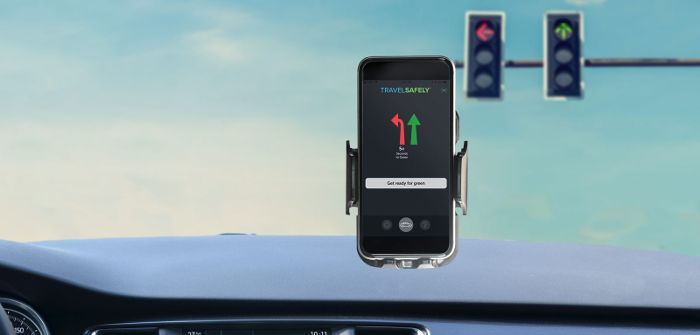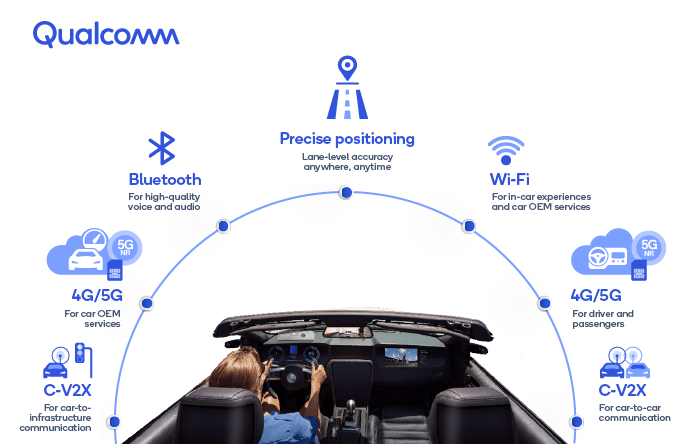Applied Information & Qualcomm to Integrate C-V2X Technology in Traffic Signals in Hawaii
【Summary】Smart City technology developer Applied Information, Inc. announced today its plans to bring Cellular Vehicle to Everything (C-V2X) technology to the island of Hawaii. The company is working with wireless technology developer Qualcomm on the pilot, in which C-V2X technology will be integrated into 34 traffic signals along the high-traffic Nimitz Corridor in Honolulu.

In the future, connected vehicles will be able to communicate directly with other nearby vehicles, traffic signals, road signs and other infrastructure. Connected vehicle technology that integrates with smart cities infrastructure will also help to make traffic flow more efficiently, and make roads safer, especially during peak travel times.
Some of these technologies are being deployed in pilot programs in cities around the world. The latest pilot to launch is in Honolulu, Hawaii.
Applied Information, Inc. announced today its plans to bring Cellular Vehicle to Everything (C-V2X) technology to the island of Hawaii. For the pilot, the C-V2X technology will be integrated into 34 traffic signals along the high-traffic Nimitz Corridor in Honolulu as a part of the Vehicle-to-Everything (V2X) part of the program.
The company's vehicle-to-network (V2N) technology allows drivers, pedestrians and the infrastructure to connect using the free Applied Information TravelSafely smartphone app. The Applied Information app connects drivers to infrastructure using data from multiple sources.
TravelSafely also connects drivers to other users that have the app, including pedestrians and cyclists, so drivers are aware of their presence.
Applied Information is a leading developer of Smart Cities technologies, including connected, intelligent transportation system (ITS) that improve traffic flow. Among its products, the company offers cities its "Glance Smart City Supervisory" web-based application, so that city planners can better manage traffic flows and signals.
The company will exclusively implement the C-V2X technologies developed by Qualcomm Technologies. Alos participating in the project is the Hawaii Department of Transportation (HDOT) and the University of Hawaii College of Engineering.
"Applied Information is pleased to work with Qualcomm Technologies to provide the latest in C-V2X connected vehicle technology for this important project for Hawaii DOT and the University of Hawaii," said Bryan Mulligan, President of Applied Information, Inc. "Hawaii is now a world leader in showing how to improve highway and pedestrian safety by using connected vehicle technology."

C-V2X is a direct communication technology designed to offer vehicles low latency communications for Vehicle-to-Vehicle (V2V), Vehicle-to-Roadside Infrastructure (V2I) and Vehicle-to-Pedestrian (V2P) without using a cellular network, or cellular service plan. Instead it operates on the designated 5.9 GHz ITS spectrum that's been designated by the FCC for connected vehicle technologies and advanced driver assist systems (ADAS).
The U.S Department of Transportation's Federal Highway Administration awarded a $6.85 million Advanced Transportation and Congestion Management Technologies Deployment (ATCMTD) grant to HDOT for its Implementing Cellular V2X technology to improve road safety.
The goal of the pilot is to eventually extend the deployment of connected vehicle infrastructure across the entire state of Hawaii, using C-V2X communications with vehicle-to-everything (V2X) capabilities for connected vehicle and traffic infrastructure. The project includes the installation and operation of a cellular-based V2X system for all traffic lights throughout the state.
C-V2X communications technology offers high performance and low latency, so connected vehicles can communicate with infrastructure like traffic lights in real-time, leading to less congestion and a smoother flow of traffic. It also can reduce vehicle emissions by reducing traffic jams and stop and go traffic that wastes fuel.
"This C-V2X program introduces the potential to greatly reduce collisions and improve mobility at high-traffic intersections across Honolulu," said Jim Misener, senior director, product management, Qualcomm Technologies, Inc. "In the short term, emergency responders and transit are beneficiaries, but over the longer term all road users could benefit from C-V2X."
Applied Information's roadside units (RSU) will provide connectivity between the traffic signals and roadway users utilizing Qualcomm's 9150 C-V2X Platform. The 9150 chipset from Qualcomm is designed to operate on the 5.9 GHz Intelligent Transportation System (ITS) spectrum. The 9150 chipset includes a C-V2X direct communication mode.
Some of the C-V2X technologies being deployed include Red Light Violation Warning, Pedestrian and Cyclist Collision Warnings, Emergency Vehicle Preemption which turns traffic lights green when emergency vehicles are enroute, Transit Signal Priority, Traffic Queue Warning, which warns drivers of a slowdown ahead, as well as Signal-Phase and Timing (SPaT).
SPaT relays all of the phases of a traffic signal (red, green, yellow) at intersections for each lane the signal controls. This data is typically used by traffic planners to improve traffic flows.
In the future, cellular vehicle-to-everything (C-V2X) will serve as the foundation for vehicles to communicate with each other and to the surroundings. C-V2X provides a 360º awareness around vehicles and nearby infrastructure for increased road safety.
The technology is also suitable for future autonomous vehicles for navigation, connecting with nearby vehicles to share real-time information on road conditions.
To assist with the pilot, the U.S. The Federal Communications Commission (FCC) granted an experimental license to operate on the 5.9 GHz spectrum for a 5-mile stretch of the Nimitz Highway and adjacent Ala Moana Boulevard.
C-V2X technology shows great promise for automakers to integrate into their vehicles to improve safety.
German automaker Audi already offers its Traffic Light Information service in some cities, which allows Audi vehicles to communicate directly with traffic signals, letting drivers know precisely when the light will change. It launched in the German city of Dieseldorf earlier this year.
Last month BMW iVentures, the venture capital arm of the automaker, invested in Austin, Texas-based GenXComm, a company working to improve the throughput and performance of 5G communication networks. The company is developing 5G hardware for V2X and V2I communications using photonic relays, which are capable of simultaneous transmit and receive (STAR) of vehicle data to and from the cloud.
Connected vehicles will transfer massive amounts of data to and from the cloud. Therefore much of the research being done by telecommunications companies is making sure 5G networks are efficient and reliable.
-


Ford is Testing a New Robotic Charging Station to Assist Drivers of EVs With Disabilities
-


Ford Raises the Prices of the F-150 Lightning Electric Pickup Due to Rising Raw Material Costs
-


The BMW 7-Series to Feature HD Live Maps From HERE Technologies for Hands-Free Highway Driving in North America at Speeds up to 80 MPH
-


AutoX to Use the 'Eyeonic Vision Sensor' from California-based SiLC Technologies for its Robotaxi Fleet in China
-


LG Develops ‘Invisible’ Speaker Sound Technology That Could Revolutionize In-Vehicle Audio
-


Researchers at South Korea’s Chung-Ang University Develop a ‘Meta-Reinforcement’ Machine Learning Algorithm for Traffic Lights to Improve Vehicle Throughput
-


Zeekr’s New 009 Electric Passenger Van is the World’s First EV to Feature CATL’s Advanced ‘Qilin’ Battery With a Range of 510 Miles
-


Redwood Materials is Building an Electric Vehicle Battery Recycling Facility in South Carolina
- Volkswagen’s Software Company CARIAD to Use BlackBerry QNX to Support ADAS and Autonomous Driving Functions of Future VW Vehicles
- GM’s Buick Division is Getting a Makeover, Will Only Offer Electric Vehicles by the End of the Decade
- EV Brand Polestar Announces $1.6 Billion in New Financing as its Stock Price Falls Below $5
- Toyota Unveils the 2023 Crown, a Lifted Hybrid Sedan With 340 HP
- Faraday Future Delays Launch of FF91 Electric SUV Again
- EV Startup Fisker Announces ‘Fisker Finance’ a Digital Financing Platform for Purchasing the Electric Ocean SUV
- Ford Motor Co is Cutting 3,000 Jobs as it Transitions to Electric Vehicles, Software and Digital Services
- The Tesla Model Y and Model 3 Take the 1st and 2nd Place Spots in the Annual Cars.com ‘American-Made Index’
- Hyundai Gets Serious About Electric Performance Cars, Shows off Two Concepts
- Researchers at South Korea’s Chung-Ang University Develop a ‘Meta-Reinforcement’ Machine Learning Algorithm for Traffic Lights to Improve Vehicle Throughput











 About Us
About Us Contact Us
Contact Us Careers
Careers